News and Analysis on scarce coins, markets, and the collecting community #93
A Weekly CoinWeek Column by Greg Reynolds
It has been a while since I have written about Liberty Seated Half Dollars. Indeed, I have not done so since August 2011, when I discussed several Liberty Seated halves that had then just been auctioned, as members of the Dick Osburn Collection. The topic here is Liberty Seated Half Dollars that were offered in the FUN Convention auction, during the Platinum Night session on Jan. 4, 2012. I have already covered many other coins that were auctioned in this same event, including bust halves last week and earlier the Eliasberg-Atwater-Jung Chain Cent that realized $1.38 million. (Clickable links are in blue.)
 Liberty Seated Half Dollars are scarce and attractive coins, which are undervalued from a logical perspective. While the uncirculated and Proof coins that I discuss here are too expensive for most collectors to obtain, Liberty Seated Half Dollars are not very costly in circulated grades, and may be good values in comparison to bust halves or Walking Liberty Half Dollars. Also, 63 grade halves tend to be much less expensive than the even higher grade coins that I discuss herein.
Liberty Seated Half Dollars are scarce and attractive coins, which are undervalued from a logical perspective. While the uncirculated and Proof coins that I discuss here are too expensive for most collectors to obtain, Liberty Seated Half Dollars are not very costly in circulated grades, and may be good values in comparison to bust halves or Walking Liberty Half Dollars. Also, 63 grade halves tend to be much less expensive than the even higher grade coins that I discuss herein.
Besides, I wish to repeat my belief that, for collectors to understand the classic coins that they own or see, there is a need to learn about coins that are not affordable. Art enthusiasts often determine that it is beneficial to learn about paintings that they cannot afford.
It is not practical to cover all of the Liberty Seated Half Dollars in this auction session. I am focusing upon ‘No Motto’ Liberty Seated Half Dollars. The motto, ‘In God We Trust,’ was added to half dollars in 1866. Liberty Seated Half Dollars were minted from 1839 to 1891.
The so called ‘No Motto’ type was minted from 1839 to 1866, and this auction featured an impressive assortment of these. Moreover, this auction contained two gem quality, 1853 ‘Arrows & Rays’ Half Dollars, a business strike and a certified Proof. These are representatives of an important one-year type.
I. 1842 ‘Small Date – Large Letters’
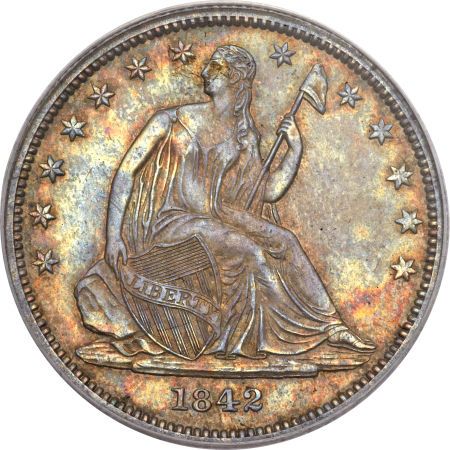 The run of Liberty Seated Half Dollars in this Platinum Night session began with an 1842 half that is PCGS graded MS-64. It is of the “Small Date, Large Letters” variety.
The run of Liberty Seated Half Dollars in this Platinum Night session began with an 1842 half that is PCGS graded MS-64. It is of the “Small Date, Large Letters” variety.
There was another 1842 ‘Small Date – Large Letters’ half sold by Heritage in a different session of this same auction extravaganza. Surprisingly, it was also PCGS graded MS-64 and it realized the exact same price, $8050! I did not see the second one.
As high grade representatives of this issue trade so infrequently, it is hard to interpret this dual $8050 result. It could be that the PCGS price guide value of $17,500 is incorrect and should be lowered.
There was also a ‘Proof’ 1842 ‘Small Date – Large Letters’ half in this auction session. All known Proof 1842 half dollars are of the ‘Small Date – Large Letters’ variety.
This one is PCGS certified ‘Proof-64.’ The Heritage cataloguer suggests that seven are known. I am not thrilled about this particular coin. The $43,125 result is strong, a full retail price.
The Proof 1845 half in this sale is PCGS certified ‘Proof-64 Cameo.’ It sold for $57,500, another strong price.
II. Background: Small Dates and Larger Dates
The ‘Small Date’ term refers to the size of the numerals on the obverse (front of the coin). The ‘Large Letters’ term refers to the size of the letters on the reverse (back of the coin). Liberty Seated Half Dollars minted from 1839 to 1841 feature letters that are smaller than the letters on halves that were minted after 1842.
There are 1842 dated halves with both reverses. The ‘Small Letters’ reverse is sometimes called the ‘Reverse of 1839,’ and the ‘Large Letters’ reverse likewise is sometimes called the ‘Reverse of 1842.’
There are three major varieties of 1842 halves: Small Date – Small Letters, Small Date – Large Letters, and Medium Date – Large Letters. The ‘Small Date – Small Letters’ coins are much rarer than the other two varieties, though the ‘Small Date – Large Letters’ is worth a considerable premium over the ‘Medium Date’ 1842 halves.
In the history of coin collecting, obverse varieties tend to be much more significant than reverse varieties, especially those varieties that relate to numerals. A readily apparent obverse variety that is characterized by differences in one or more numerals, such as notably smaller numerals, is more likely, than other varieties, to have the status of a distinct ‘date.’
Randy Wiley and Bill Bugert have analyzed varieties of Liberty Seated Half Dollars and incorporated their findings into a book, which was published in 1993. This Wiley-Bugert (WB) book is available online at the DLRC website. They measured the height of the numerals on Liberty Seated Half Dollars.
In relation to coins, the term ‘date’ has more than one meaning. In the context of Small Date, Medium Date and Large Date designations, the date refers to the physical numerals of the respective year that appears on each coin.
According to Wiley and Bugert, Liberty Seated Halves of 1839 to 1841, plus some 1842s, have a ‘Small Date,’ which measures from 0.056 to 0.064 inch in height. As I already noted, other 1842s have a ‘Medium Date.’ The numerals in ‘Medium Dates’ vary from 0.076 to 0.086 inch. All half dollars of the following years are said by Wiley and Bugert to each have a ‘Medium Date’: 1843-45, 1859-74, 1876-85, and 1888-91.
In contrast, a ‘Large Date,’ which is sometimes termed a ‘Tall Date,’ measures from 0.086 to 0.096 inch in height. Wiley and Bugert report that Liberty Seated Half Dollars dating from 1847 to 1857, and also those of 1875, each have a ‘Large Date.’ It is curious that the 1875 is the lone year from a different era to have a ‘Large Date.’ Halves of 1858, 1886 and 1887 are said to each have an ‘Extremely Large Date,’ which is approximately 0.1 inch in height, give or take 0.02 inch.
The 1842 ‘Medium Date’ coins are often wrongly cited as having a ‘Large Date.’ Among Liberty Seated Half Dollars, 1846 seems to be the only year for which both ‘Medium Date’ and ‘Large Date’ coins are known. ‘Large Date’ and ‘Tall Date’ 1846 halves are the same coins.
III. 1846 Halves
The 1846 ‘Large Date’ (also known as “Tall Date”) is rarer in ‘mint state’ grades than the 1846 ‘Medium Date’ issue. Indeed, the 1846 ‘Large Date’ is probably rare in all grades.
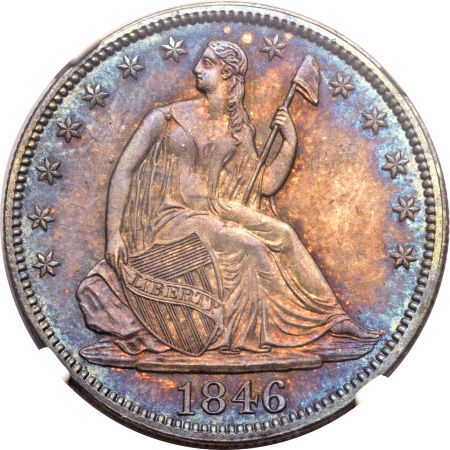 The 1846 ‘Large Date’ in this auction is NGC graded MS-66. I just glanced at it quickly. I tentatively agreed with the 66 grade.
The 1846 ‘Large Date’ in this auction is NGC graded MS-66. I just glanced at it quickly. I tentatively agreed with the 66 grade.
Matt Kleinsteuber carefully inspected it. He is very enthusiastic about this ‘Large Date’ 1846. It has “beautiful russets and blues,” Matt exclaims, “a true Superb Gem, wonderful.” Kleinsteuber is the lead trader and grader for NFC coins.
This 1846 ‘Large Date’ realized $25,300. If it was an 1846 ‘Medium Date,’ it would not have sold for as much. In this case, the premium for the ‘Large Date’ is perhaps $8000.
There were two Proof 1846 ‘Medium Date’ halves in this auction. The values of these Proof 1846 halves should not be directly compared to the values of 1846 business strikes, as Proofs are much rarer and are more expensive.
Each certified Proof 1846 in this sale is PCGS graded ‘64’ and is CAC approved. The first, at $35,937.50, brought slightly more than the second, which went for $34,500. Both prices are fair, though I feel more comfortable about the first coin than about the second. While the second Proof 1846 is more sharply detailed, the toning, surface quality and overall ‘look’ of the first are better.
Importantly, this session contained six Liberty Seated Half Dollars from the 1840s that are certified as Proofs by the PCGS or the NGC. All Proof issues from the 1840s are very rare.
IV. Eliasberg 1847
The Proof 1847 half from the Eliasberg Collection was in this sale. It is NGC certified Proof-64.
Louis Eliasberg formed the all-time greatest collection of U.S. coins and he had an excellent collection of world coins. This half dollar was auctioned by B&M of New Hampshire during April 1997, in New York.
On Jan. 4, 2012, the Eliasberg Proof 1847 half did not sell. I was present when the lot was offered. My impression is that a commitment of at least $24,750 would have been required to compete for it. The reserve was too high.
Consider the Pittman-Kaufman 1847, which is also NGC certified ‘Proof-64.’ It sold for $27,600 on July 31, 2008 when coin markets were peaking, for $16,100 in April 2009, when coin markets were bottoming, and for $16,675 in August 2011, at which time it was part of the Dick Osburn Collection.
It did not make sense for the consignor to require that bidding start at nearly $25,000 for the Eliasberg 1847. Even a collector or dealer willing to pay $25,000 may have wished to ‘see’ someone else bid before committing. There is a good chance, though, no bidder was willing to pay more than $21,500 for this coin on Jan. 4, 2012.
I like the Eliasberg 1847. Proof silver coins from the 1840s tend to be somewhat dark. This is often, though not always, an important sign of originality. Furthermore, natural medium to deep toning, of expected colors, should be celebrated, not penalized as one grading service seems to do. (Please see my three part series on appreciating naturally toned coins.) In my view, this Eliasberg 1847 half is certainly a Proof, is more than attractive, has naturally toned, and merits a grade in the middle of the 64 range.
V. 1853 Arrows & Rays
The quarters and halves of 1853, with ‘Arrows & Rays,’ are among the most famous and curious of type coins. Only in 1853, quarters and half dollars featured arrows on the obverse (front) and rays on the reverse (back). These are generally determined to be one-year type coins, or at least need to be regarded as a one-year subtype of Liberty Seated Quarters and Half Dollars, respectively.
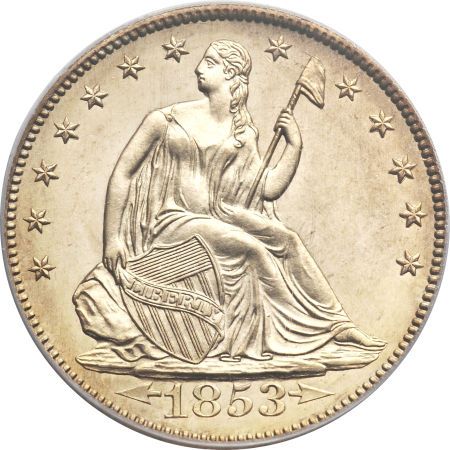 Arrows & Rays Half Dollars are thus highly demanded by collectors who are assembling type sets. This auction featured both a business strike and a Proof 1853 with Arrows & Rays!
Arrows & Rays Half Dollars are thus highly demanded by collectors who are assembling type sets. This auction featured both a business strike and a Proof 1853 with Arrows & Rays!
The business strike is PCGS graded MS-66 and has a CAC sticker. It has been moderately dipped and has naturally retoned to some extent. Further, it is mildly lustrous and has very few contact marks. In my view, its grade is around the border between MS-65 and MS-66. I am less favorably inclined, though, towards very apparently dipped coins than are the graders at the PCGS, the NGC, and the CAC.
This business strike sold for $69,000, which John Albanese finds to be “a strong price.” Indeed, I did not expect this coin to realize even $57,500. It did, though, realize this exact same $69,000 price at the Jan. 2008 FUN auction, four years ago. So, it is not quite fresh. Also, market levels for rare U.S. coins in general were higher in Jan. 2008 than in Jan. 2012.
For this issue, the PCGS has graded thirteen as MS-65, four as MS-66 and two as MS-67. This total of nineteen ‘gems’ undoubtedly includes multiple counts of some of the same individual coins. The NGC reports sixteen in MS-66 and zero higher. I doubt that these sixteen are all different coins, maybe nine of them are different. I have seen other gem business strikes of this ‘Arrows & Rays’ Half Dollar issue that I prefer to the one in this auction.
Any “Proof” 1853 Arrows & Rays half is extremely important. According to Heritage cataloguers, just five or six exist. At the moment, I recollect seeing just one other of this issue.
The one in this auction is PCGS certified ‘Proof-65’ and has a CAC sticker. Bruce Morelan reveals “that this is the Nevada collection coin.” (Please click to read my article on The Spectacular Nevada Accumulation and the Morelan Collection of Type Coins. )
Bruce Morelan had included this half in his type set. For reasons apart from the present or future market prices of coins, Bruce decided to sell his half dollars and he consigned this ‘Proof’ 1853 to this auction.
The finish on the 1853 ‘Arrows & Rays’ halves that are certified as ‘Proofs’ is substantially different from the finishes on certified Proof Liberty Seated Half Dollars of most other dates from the 1840s to the 1860s. Plus, there are other significant differences. These 1853s are very interesting coins.
While these special 1853 Arrows & Rays halves (and corresponding quarters) are not business strikes, I have never felt certain that “Proof” is an appropriate term for them, though I have come to accept it. When I reflect upon many of the silver coins from the 1850s that the PCGS or the NGC has certified as ‘Proofs,’ especially those with some or most design elements (devices) that are not even close to Proof ideals, this coin and probably a few similar ‘Arrows & Rays’ Half Dollars qualify as Proofs, in accordance with the criteria employed by the PCGS and the NGC, respectively. Certainly, these are close to being Proofs, special strikings of some kind.
The Nevada-Morelan ‘Proof’ 1853 was dipped, maybe more than twenty-five years ago. It has been naturally retoning to an extent. Further, this coin has minor hairlines and contact marks, mostly on the obverse (front). In my view, this coin’s grade is in the ‘low end’ to middle part of the 65 range, somewhere between 65.25 and 65.4.
This Nevada-Morelan 1853 realized $184,000, a price that John Albanese says “is about right”! Although the PCGS price guide value is “$200,000,” I regard this $184,000 result as a strong price, well within the retail range.
In 2007, Heritage auctioned the Kaufman 1853 Arrows & Rays half for $149,500. It is NGC certified “Proof-66.”
VI. Proof 1857
The Proof 1857 half in this auction is PCGS graded Proof-65 and has a CAC sticker. “It is beautiful,” John Albanese exclaims. John reveals that he bid, or was planning to bid up to, $34,500 for this coin. It sold for $35,937.50.
 This exact same coin was auctioned by Heritage on July 31, 2008, when coin markets were literally peaking. It then realized $28,750. The Numismedia.com retail guide value for this coin is “$15,310,” as of Jan. 30, 2012. Proof 1857 halves, however, are rare in all grades and are distinct condition rarities in 65 grade. Guide prices may not be even close to actual market prices as Proof-65 1857 halves do not trade very often.
This exact same coin was auctioned by Heritage on July 31, 2008, when coin markets were literally peaking. It then realized $28,750. The Numismedia.com retail guide value for this coin is “$15,310,” as of Jan. 30, 2012. Proof 1857 halves, however, are rare in all grades and are distinct condition rarities in 65 grade. Guide prices may not be even close to actual market prices as Proof-65 1857 halves do not trade very often.
In general, Proof 1857s are rarer than Proof Liberty Seated Half Dollars of the 1860 to 1865 time period, which are of the same ‘No Motto’ type. The current PCGS price guide value is $35,000 for this coin, though I did not check this guide value prior to the auction.
The PCGS has certified just two 1857 halves as ‘Proof-65’ and none have been PCGS certified at a higher level. The NGC has certified three as ‘Proof-65’ and just two higher. This is the only certified ‘Proof-65’1857 half that is CAC approved, and the CAC has not stickered one of a higher grade.
The point of citing such data here is to further demonstrate that it is very difficult to gauge the market value of and analyze the auction result for this specific coin. Overall rarity, condition rarity, individual attractiveness, place of this coin’s grade in the 65 range, number of people collecting Proof Liberty Seated Half Dollars ‘by date,’ and other factors may have contributed to the auction result.
VII. 1859 Business Strike
Business Strike 1859 halves are scarce in all grades. Further, these are extremely rare in MS-65 and higher grades. The one in this sale is NGC graded MS-66 and has a CAC sticker. While 66 is a fair grade, its grade is not even near the high end of the 66 range, in my view. The $19,550 result is very strong. I was expecting a price in the $12,500 to $15,500 range.
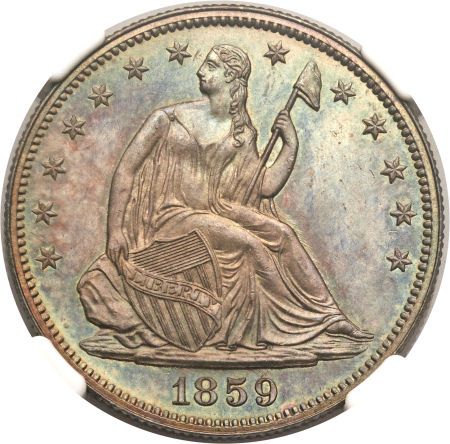 This 1859 business strike is one of the finest known representatives of this issue. Only two have been PCGS graded MS-66 and none have received a grade higher than MS-66 from the PCGS. Three have been graded MS-66 by the NGC and one has been graded MS-67. Not all the NGC graded MS-66 1859 halves, though, would be graded MS-66 by the PCGS.
This 1859 business strike is one of the finest known representatives of this issue. Only two have been PCGS graded MS-66 and none have received a grade higher than MS-66 from the PCGS. Three have been graded MS-66 by the NGC and one has been graded MS-67. Not all the NGC graded MS-66 1859 halves, though, would be graded MS-66 by the PCGS.
The originality of this coin probably was a factor in its strong realization. The deep brownish-russet tones, and blue hues in some areas, are soothing. Furthermore, it has very few contact marks. This 1859 is a pleasing coin overall.
VIII. Proof 1860
The 1860 half in this auction is PCGS certified ‘Proof-67+ Cameo.’ It sold for $43,125. The PCGS price guide value is $43,500. This coin glistens.
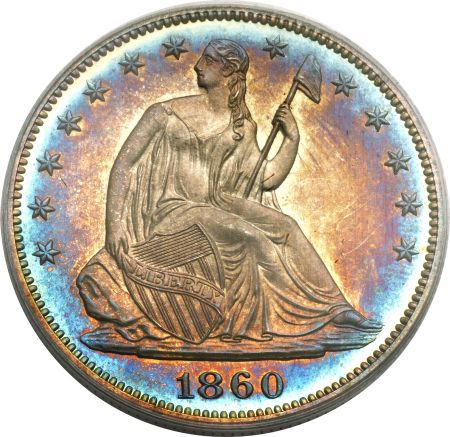 Matt Kleinsteuber reveals that he “was the consignor” and was excited about this coin. “It is very pretty. It is devoid of hairlines. I made it,” meaning that Matt was the submitter when it was graded ‘67+.’ “It is one of the best ‘No Motto’ Proof Seated Half dollars that I have ever seen. I thought it would bring more money,” Kleinsteuber declares.
Matt Kleinsteuber reveals that he “was the consignor” and was excited about this coin. “It is very pretty. It is devoid of hairlines. I made it,” meaning that Matt was the submitter when it was graded ‘67+.’ “It is one of the best ‘No Motto’ Proof Seated Half dollars that I have ever seen. I thought it would bring more money,” Kleinsteuber declares.
I did not expect it to realize a higher price. In my view, the $43,125 result is strong.
High quality, Proof Liberty Seated Half Dollars, in general, tend to be very attractive. I am surprised that more people do not collect them.
Collecting Proofs of the post-1866 types and/or business strikes of the pre-1866 types would be enjoyable, in my view. Furthermore, I am surprised that more people do not assemble type sets of Liberty Seated Half Dollars and/or coins of other Liberty Seated series.
Each collector may choose a grade range that matches his or her budget and tastes. Most circulated Liberty Seated type coins are not expensive. Even a type set of uncirculated Liberty Seated Half Dollars is not costly relative to prices in general for uncirculated 19th century U.S. silver coins.
©2012 Greg Reynolds





Nice article, great coins. The seated 50C is a really nice design, and these are great examples.
I have a 1842 seated liberty. On the back is an eagle with uplifted spread wings. Did they mint any like this or is this a counterfete?